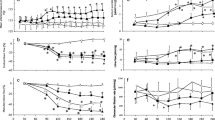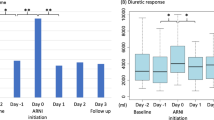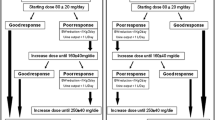Abstract
Objective
Imbalance in the renal medullary oxygen supply/demand relationship can cause hypoxic medullary damage and ischemic acute renal failure. Human atrial natriuretic peptide (h-ANP) increases glomerular filtration rate in clinical acute renal failure. This would increase renal oxygen consumption due to increased tubular load of sodium. Loop diuretics are commonly used in acute renal failure. Data on the effects of loop diuretics on glomerular filtration rate and renal oxygen consumption in humans are, however, controversial. We evaluated the effects of h-ANP and furosemide on renal oxygen consumption, glomerular filtration rate, and renal hemodynamics in humans.
Design and setting
Prospective two-agent interventional study in a university hospital cardiothoracic ICU
Patients
Nineteen uncomplicated, mechanically ventilated postcardiac surgery patients with normal renal function.
Interventions
h-ANP (25 and 50 ng/kg per minute, n=10) or furosemide (0.5 mg/kg per hour, n=9)
Measurements and results
Renal plasma flow and glomerular filtration rate were measured using the infusion clearance technique for 51Cr-labeled EDTA and paraaminohippurate, corrected for by renal extraction of PAH. h-ANP increased glomerular filtration rate, renal filtration fraction, fractional excretion of sodium, and urine flow. This was accompanied by an increase in tubular sodium reabsorption (9%) and renal oxygen consumption (26%). Furosemide infusion caused a 10- and 15-fold increase in urine flow and fractional excretion of sodium, respectively, accompanied by a decrease in tubular sodium reabsorption (–28%), renal oxygen consumption (–23%), glomerular filtration rate and filtration fraction (–12% and −7%, respectively).
Conclusions
The filtered load of sodium is an important determinant of renal oxygen consumption. h-ANP improves glomerular filtration rate but does not have energy-conserving tubular effects. In contrast, furosemide decreases tubular sodium reabsorption and renal oxygen consumption and thus has the potential to improve the oxygen supply/demand relationship in clinical ischemic acute renal failure.
Similar content being viewed by others
References
Andersson LG, Ekroth R, Bratteby LE, Hallhagen S, Wesslen O (1993) Acute renal failure after coronary surgery—a study of incidence and risk factors in 2009 consecutive patients. Thorac Cardiovasc Surg 41:237–241
Mangano CM, Diamondstone LS, Ramsay JG, Aggarwal A, Herskowitz A, Mangano DT (1998) Renal dysfunction after myocardial revascularization: risk factors, adverse outcomes, and hospital resource utilization. The Multicenter Study of Perioperative Ischemia Research Group. Ann Intern Med 128:194–203
Conlon PJ, Stafford-Smith M, White WD, Newman MF, King S, Winn MP, Landolfo K (1999) Acute renal failure following cardiac surgery. Nephrol Dial Transplant 14:1158–1162
Brezis M, Rosen S (1995) Hypoxia of the renal medulla-its implications for disease. N Engl J Med 332:647–655
Block CA, Manning HL (2002) Prevention of acute renal failure in the critically ill. Am J Respir Crit Care Med 165:320–324
Brezis M, Agmon Y, Epstein FH (1994) Determinants of intrarenal oxygenation. I. Effects of diuretics. Am J Physiol 267:F1059–1062
Shilliday I, Allison ME (1994) Diuretics in acute renal failure. Ren Fail 16:3–17
Kramer HJ, Schuurmann J, Wassermann C, Dusing R (1980) Prostaglandin-independent protection by furosemide from oliguric ischaemic renal failure in conscious rats. Kidney Int 17:455–464
Hanley MJ, Davidson K (1981) Prior mannitol and furosemide infusion in a model of ischaemic acute renal failure. Am J Physiol 241:F556–564
Bayati A, Nygren K, Kallskog O, Wolgast M (1990) The effect of loop diuretics on the long-term outcome of post-ischaemic acute renal failure in the rat. Acta Physiol Scand 139:271–279
Kuramochi G, Homma S (1993) Effects of furosemide on renal oxygen consumption after ischemia in normal and streptozotocin diabetic rats. Nephron 64:436–442
Kim SJ, Lim YT, Kim BS, Cho SI, Woo JS, Jung JS, Kim YK (2000) Mechanism of reduced GFR in rabbits with ischaemic acute renal failure. Ren Fail 22:129–141
Lassnigg A, Donner E, Grubhofer G, Presterl E, Druml W, Hiesmayr M (2000) Lack of renoprotective effects of dopamine and furosemide during cardiac surgery. J Am Soc Nephrol 11:97–104
Mehta RL, Pascual MT, Soroko S, Chertow GM (2002) Diuretics, mortality, and nonrecovery of renal function in acute renal failure. JAMA 288:2547–2553
Brenner BM, Ballermann BJ, Gunning ME, Zeidel ML (1990) Diverse biological actions of atrial natriuretic peptide. Physiol Rev 70:665–699
Conger JD, Falk SA, Yuan BH, Schrier RW (1989) Atrial natriuretic peptide and dopamine in a rat model of ischaemic acute renal failure. Kidney Int 35:1126–1132
Nakamoto M, Shapiro JI, Shanley PF, Chan L, Schrier RW (1987) In vitro and in vivo protective effect of atriopeptin III on ischaemic acute renal failure. J Clin Invest 80:698–705
Schafferhans K, Heidbreder E, Grimm D, Heidland A (1986) Norepinephrine-induced acute renal failure: beneficial effects of atrial natriuretic factor. Nephron 44:240–244
Rahman SN, Kim GE, Mathew AS, Goldberg CA, Allgren R, Schrier RW, Conger JD (1994) Effects of atrial natriuretic peptide in clinical acute renal failure. Kidney Int 45:1731–1738
Valsson F, Ricksten SE, Hedner T, Lundin S (1996) Effects of atrial natriuretic peptide on acute renal impairment in patients with heart failure after cardiac surgery. Intensive Care Med 22:230–236
Valsson F, Ricksten SE, Hedner T, Zall S, William-Olsson EB, Lundin S (1994) Effects of atrial natriuretic peptide on renal function after cardiac surgery and in cyclosporine-treated heart transplant recipients. J Cardiothorac Vasc Anesth 8:425–430
Sward K, Valson F, Ricksten SE (2001) Long-term infusion of atrial natriuretic peptide (ANP) improves renal blood flow and glomerular filtration rate in clinical acute renal failure. Acta Anaesthesiol Scand 45:536–542
Brezis M, Heyman SN, Epstein FH (1994) Determinants of intrarenal oxygenation. II. Haemodynamic effects. Am J Physiol 267:F1063–1068
Zeidel ML, Seifter JL, Lear S, Brenner BM, Silva P (1986) Atrial peptides inhibit oxygen consumption in kidney medullary collecting duct cells. Am J Physiol 251:F379–383
Tidgren B, Brodin U (1988) Plasma renin activity and oxygen content along the renal veins in hypertensive patients. Clin Physiol 8:407–416
Bland JM, Altman DG (1995) Calculating correlation coefficients with repeated observations. I. Correlation within subjects. BMJ 310:446
Lassen NA, Munck O, Thaysen JH (1961) Oxygen consumption and sodium reabsorption in the kidney. Acta Physiol Scand 51:371–384
Kiil F, Aukland K, Refsum HE (1961) Renal sodium transport and oxygen consumption. Am J Physiol 201:511–516
Metzler CH, Ramsay DJ (1989) Physiological doses of atrial peptide inhibit angiotensin II-stimulated aldosterone secretion. Am J Physiol 256:R1155–1159
Maack T, Marion DN, Camargo MJ, Kleinert HD, Laragh JH, Vaughan ED Jr, Atlas SA (1984) Effects of auriculin (atrial natriuretic factor) on blood pressure, renal function, and the renin-aldosterone system in dogs. Am J Med 77:1069–1075
Burnett JC Jr, Granger JP, Opgenorth TJ (1984) Effects of synthetic atrial natriuretic factor on renal function and renin release. Am J Physiol 247:F863–866
Gadano A, Moreau R, Vachiery F, Soupison T, Yang S, Cailmail S, Sogni P, Hadengue A, Durand F, Valla D, Lebrec D (1997) Natriuretic response to the combination of atrial natriuretic peptide and terlipressin in patients with cirrhosis and refractory ascites. J Hepatol 26:1229–1234
Aukland K, Johannesen J, Kiil F (1969) In vivo measurements of local metabolic rate in the dog kidney. Effect of mersalyl, chlorothiazide, ethacrynic acid and furosemide. Scand J Clin Lab Invest 23:317–330
Ofstad J, Willassen Y, Gjengsto H (1972) The effect of furosemide upon renal oxygen consumption in the human kidney. Acta Med Scand 192:95–97
Epstein FH, Prasad P (2000) Effects of furosemide on medullary oxygenation in younger and older subjects. Kidney Int 57:2080–2083
Mackay IG, Muir AL, Watson ML (1984) Contribution of prostaglandins to the systemic and renal vascular response to frusemide in normal man. Br J Clin Pharmacol 17:513–519
MacDonald TM, Craig K, Watson ML (1989) Frusemide, ACE inhibition, renal dopamine and prostaglandins: acute interactions in normal man. Br J Clin Pharmacol 28:683–694
Passmore AP, Copeland S, Johnston GD (1990) The effects of ibuprofen and indomethacin on renal function in the presence and absence of frusemide in healthy volunteers on a restricted sodium diet. Br J Clin Pharmacol 29:311–319
Guidi E, Colussi G, Rombola G, Airaghi C, Minetti E, Malberti F (1995) Evaluation of the tubuloglomerular feedback system in human subjects. Exp Nephrol 3:61–64
Bradley VE, Shier MR, Lucas CE, Rosenberg IK (1976) Renal haemodynamic response to furosemide in septic and injured patients. Surgery 79:549–554
Tenstad O, Williamson HE (1995) Effect of furosemide on local and zonal glomerular filtration rate in the rat kidney. Acta Physiol Scand 155:99–107
Acknowledgements
The technical assistance of Marita Ahlqvist and the assistance of the nursing staff of the Cardiothoracic Intensive Care Unit and Surgical Theatre of the Sahlgrenska University Hospital are gratefully acknowledged.
Author information
Authors and Affiliations
Corresponding author
Additional information
This research was supported by grants from the Swedish Medical Research Council (no. 13156), Medical Faculty of Gothenburg (LUA), and Gothenburg Medical Society.
Rights and permissions
About this article
Cite this article
Swärd, K., Valsson, F., Sellgren, J. et al. Differential effects of human atrial natriuretic peptide and furosemide on glomerular filtration rate and renal oxygen consumption in humans. Intensive Care Med 31, 79–85 (2005). https://doi.org/10.1007/s00134-004-2490-3
Received:
Accepted:
Published:
Issue Date:
DOI: https://doi.org/10.1007/s00134-004-2490-3




